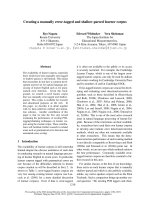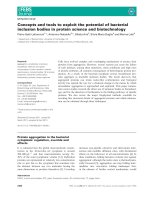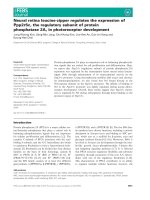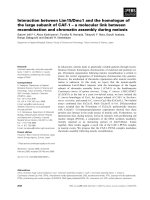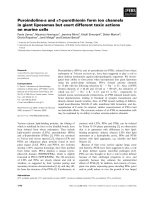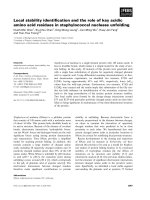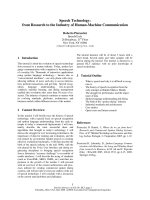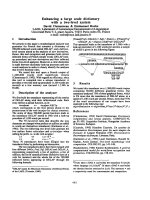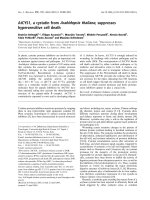báo cáo khoa học: " Impact: a case study examining the closure of a large urban fixed site needle exchange in Canada" ppt
Bạn đang xem bản rút gọn của tài liệu. Xem và tải ngay bản đầy đủ của tài liệu tại đây (509.78 KB, 8 trang )
MacNeil and Pauly Harm Reduction Journal 2010, 7:11
/>Open Access
CASE STUDY
© 2010 MacNeil and Pauly; licensee BioMed Central Ltd. This is an Open Access article distributed under the terms of the Creative Com-
mons Attribution License ( which permits unrestricted use, distribution, and reproduc-
tion in any medium, provided the original work is properly cited.
Case study
Impact: a case study examining the closure of a
large urban fixed site needle exchange in Canada
Joan MacNeil*
†
and Bernadette Pauly
†
Abstract
Introduction: In 2008, one of the oldest fixed site needle exchanges in a large urban city in Canada was closed due to
community pressure. This service had been in existence for over 20 years.
Case Description: This case study focuses on the consequences of the switch to mobile needle exchange services
immediately after the closure and examines the impact of the closure on changes in risk behavior related to drug use,
needle distribution and access to services The context surrounding the closure was also examined.
Discussion and Evaluation: After the closure of the fixed site exchange, access to needle exchange services
decreased as evidenced by the sharp decline in numbers of clients reached, and the numbers of needles distributed
and collected monthly. Reports related to needle reuse and selling of syringes suggest changes in risk behaviors.
Thousands of needles remain unaccounted for in the community. To date, a new fixed site has not been found.
Conclusion: Closing the fixed site needle exchange had an adverse effect on already vulnerable clients and reduced
access to comprehensive harm reduction services. While official public policy supports a fixed site, politicization of the
issue has meant a significant setback for harm reduction with reduced potential to meet public health targets related
to reducing the spread of blood borne diseases. This situation is unacceptable from a public health perspective.
Introduction
Needle exchange programs have been operating with
government funding throughout Canada since the late
1980s. They are generally regarded as one of the most
important factors in preventing HIV epidemics among
those who use injection drugs in Canada [1,2]. Most com-
munity-based needle exchange programs provide a non-
judgmental setting for people who use injecting drugs to
dispose of used injection equipment, access sterile
syringes and other injecting paraphernalia, condoms and
HIV prevention education [3]. Many also offer free HIV
testing, counseling and support and referrals for health
and other social services. Community based needle
exchanges were developed over two decades ago in
response to concerns about risks of injection-related HIV
transmission [4,5].
On May 31, 2008, after over twenty years of operation,
the single fixed site needle exchange in one large urban
center closed its doors. The purpose of this paper is to
describe events associated with the closure of the only
fixed site in the city and to examine the impact of the clo-
sure on patterns of risk behavior related to drug use, dis-
tribution of injection supplies and access to services.
The overarching research question was "what was the
impact of the closure on drug related risk behavior, nee-
dle distribution and access to servicesγ" We are focusing
specifically on the perspectives of clients and providers as
to the impact of the closure on patterns of drug use in the
community, risk behaviors associated with drug use, the
numbers of needles exchanged pre and post closure, and
changes in access to services.
Case Description
Case study methodology is used most effectively to study
specific phenomena in a real world context when it is not
possible to separate the phenomena of study from the set-
ting or context [6,7]. Case studies are particularly useful
when it is not possible to manipulate variables and it is
important to include the contextual factors that are rele-
vant to the phenomena being studied [6]. In this report,
the phenomenon of interest is the impact of the closure of
* Correspondence:
1
School of Nursing, University of Victoria, P.O. Box 1700, Victoria, BC, V8W 2Y2,
Canada
†
Contributed equally
Full list of author information is available at the end of the article
MacNeil and Pauly Harm Reduction Journal 2010, 7:11
/>Page 2 of 8
the single fixed site needle exchange in a large urban cen-
ter. Thus, the unit of analysis or case, is the closure of the
fixed site needle exchange. We have used a chronological
approach and focused on describing the series of events
including the historical, social and political factors that
contributed to the closure and the aftermath of the clo-
sure of the fixed site.
The data included for analysis were drawn from local
police call data pre and post closure for the street and
surrounding streets where the fixed site was located,
agency records related to needle distribution and client
contacts pre and post closure, ten in-depth semi-struc-
tured interviews with clients, 3 client focus groups (con-
sisting of six, five, and five clients respectively), one focus
group consisting of six service providers, five individual
interviews with health care providers and police officers
and participant observation. Participant observation
included observing mobile outreach. During mobile out-
reach, one of the researchers accompanied street out-
reach workers on bicycle or foot, and the other researcher
accompanied workers at a mobile van.
Data were collected over a five month period after the
closure. This length of time was selected to allow clients
to adjust to the change in service delivery but also to be
recent enough that clients would recall the use of the
fixed site. In consultation with the outreach workers, we
anticipated that the closure would have impacts on pat-
terns of risk behaviors related to drug use, needle distri-
bution and access to services and wanted to better
understand and describe these impacts. We sought to
gain an understanding of the phenomena from a variety
of perspectives in order to enhance data quality and pro-
vide a basis for comparison and contrast in relation to the
impact of the closure.
Before data collection began, this study was approved
by the researchers' university ethics board, as well as the
NGO providing the exchange services. Voluntary
informed verbal or written consent was obtained before
each interview, observation, and focus group. All of the
interviews and focus groups were audiotaped and tran-
scribed. Field notes were recorded and transcribed. Reoc-
curring themes and patterns related to the impacts of the
closure were identified. Findings were checked and con-
firmed between the researchers and with agency staff and
clients.
Historical, Political and Social Context
Needle exchange services in this city were initiated in
1988 with first a mobile then a single fixed site exchange
in the downtown core. Over the years, the NGO- run ser-
vices expanded to include street outreach, health refer-
rals, sexual and drug education, health promotion, HIV
positive support groups and prison outreach. The popu-
lations accessing these services also increased from a
handful of clients in 1988 to several thousand by 2008 [8].
In 2007, a feasibility study on "supervised consumption
options" in the city [9] identified critical service gaps for
drug users, specifically with regard to detoxification,
treatment, housing/shelter, and basic social and health
care. These gaps were also identified seven years earlier in
another research study [10]
While the exact number is not known, there are an esti-
mated 1,500 to 2,000 people who use injection drugs in
the city area [11,12]. Illicit substance use, including injec-
tion drug use, often coincides with homelessness,
increasing the vulnerability of individuals to not only HIV
and hepatitis C, but also to poor health as a result of inad-
equate shelter, poor nutrition, violence and poverty. As
part of a homeless needs survey, it was estimated that
about 1, 242 people in this city were homeless or unstably
housed [13]. Although 78% of participants cited afford-
able housing as a barrier, almost half (47%) of the partici-
pants in that survey reported alcohol or drug use and 41%
of participants indicated that alcohol and drug use was
one of three major factors contributing to inadequate
housing. At the time of this case study analysis, another
survey of 105 clients of the needle exchange, found that
more than half the sample were homeless, had lived in the
area for a long time, and were an older street-entrenched
population of injection drug users [14].
Despite efforts to reach more clients with comprehen-
sive HIV and hepatitis C (HCV) prevention services,
some disquieting trends exist. This city was one site
among a total of seven Canadian cities, for the I-Track
study, a cross-sectional surveillance survey of risk behav-
iours and prevalence of HIV and hepatitis C virus (HCV)
among people who use injection drugs. The data for the
I-Track study (n = 250) revealed that the prevalence of
HIV and HCV remains unacceptably high among those
who use injecting drugs at 15.4% for HIV and 68.5% for
HCV [15]. In addition, drug consumption patterns could
be contributing to the increased risk of exposure. While
heroin may be injected 1-2 times a day, addiction to
cocaine requires more frequent injections. Over 70% of
the people who reported using injection drugs in the
2006 sample, reported injecting cocaine as their most
common drug over the past 6 months, with over 50%
reporting injecting more than 6 times per day [15].
Prior to the closing in 2008, the fixed site needle
exchange was open seven days a week from 3 pm to 11
pm in the evening with additional hours on Sundays. Ser-
vices, including needle exchange, were provided by the
outreach staff. Nurses were at the exchange at these times
every week day, to provide health services such as abscess
care, counseling, testing for STDs, HIV and HCV as well
as health referrals. In addition to the needle exchange and
nursing services, the fixed site offered addictions refer-
rals, shelter requests, clothing requests, hospital referrals
(rides), transportation referrals, phone outreach, counsel-
MacNeil and Pauly Harm Reduction Journal 2010, 7:11
/>Page 3 of 8
ing, hygiene supplies, comprehensive prevention educa-
tion, other harm reduction services, and sometimes food.
Despite the increased demand for harm reduction ser-
vices in the city, the NGO operating the fixed site
exchange received an eviction notice from their landlord.
This notice was in response to complaints from neigh-
bors on the street regarding open street drug use, loiter-
ing and garbage. The landlord offered that if the
organization closed the fixed site needle exchange, the
NGO could remain in the building and continue delivery
of other support and health services which included a
large HIV Support program, educational sessions and
volunteer outreach. Prior to the closure, the NGO
worked with the city and the regional health authority to
try to find a new location for a fixed site needle exchange
but due to concerns of nearby neighbours, particularly an
elementary school, efforts to relocate to a new site were
unsuccessful [16-20]. Following the closure, a community
based needle exchange advisory committee was mobi-
lized with the goal of finding a new location for a fixed
site [21]. After over 18 months, multiple attempts to find
a location and final rejection of a selected site by those
who use drugs among others, the committee was dis-
banded [22]. While the city and public health authorities
articulate support of harm reduction priorities and ser-
vices [23-25], more than a year and a half after the clo-
sure, a new location for a fixed site has not been
identified.
Following the closure of the fixed site, service delivery
shifted from a fixed site needle exchange to mobile ser-
vices. Services consist of a van parked on a side street
away from the downtown core area and mobile outreach
on bicycles and by foot. The street where the van is
parked was agreed upon by the city, the police and the
NGO providing the needle exchange services. The van
exchange and mobile outreach operate in the evenings,
seven days a week. After the closure of the fixed needle
exchange, nursing services were available at the NGO
building site only one afternoon per week, whereas prior
to the closure, the nurses were at the fixed site needle
exchange, every evening from 3 pm to 11 pm. Although
nurses also increased their strolls and drives around the
downtown core, the hours of outreach nursing services
were reduced with the closure of the fixed site. Following
the closure of the fixed site, efforts were made by other
service providers to increase secondary distribution of
clean supplies for injecting with prepackaged packets of
syringes and injecting equipment prepared and available
to clients upon request. The health authority also
increased the number of sites where injecting equipment
is available [26].
Pressure from neighborhood groups also led to the cre-
ation of a "No go Zone" post closure for mobile needle
exchange services. This "No go Zone" consisted of the
street where the fixed exchange had existed and covered a
two block radius where a private elementary school and a
large homeless shelter were located. The rules for the "No
go Zone" were that harm reduction outreach workers
could not conduct any needle exchange in this area. How-
ever, this area is frequented by many clients of the needle
exchange, especially those who are homeless. As part of
the "No go Zone" outreach workers were instructed to ask
clients who requested clean supplies to walk with them to
an area outside of the zone before they could provide
clean supplies for injecting. Also code of conduct prohib-
ited needle exchange in front of residences, open busi-
nesses, schools and day-care centers. Outreach staff are
expected to abide by this Code of Conduct not to conduct
needle exchange in these areas.
Changes in Distribution of Needles Pre and Post Closure
After the closure of the fixed site, the numbers of needles
distributed and collected by the NGO decreased dramati-
cally (see Table 1). Needle distribution in June, 2008, after
the closure, was down 40% and intake decreased by 72%
compared to April. The numbers of needles distributed
and recovered has continued to be lower than pre-closure
rates. Previously, the NGO service provider reported a
greater than 80% return rate [8]. At the same time, out-
reach workers are not reporting finding more discarded
needles on the streets. Even though some other service
providers are distributing and recovering needles, the
numbers overall have not reached pre-closure levels (see
Table 2). Thus, leaving has thousands of needles unac-
counted for in the community, potentially being reused or
shared.
Change in Number and Type of Client Contacts
The number of clients accessing the needle exchange
dropped dramatically after the closure of the fixed site,
from 373 in May to 273 in June and 277 in July. The
majority of the clients reached in June and July were
reached by the outreach on foot and/or the bikes, as
opposed to the mobile van.
After the closure of the fixed site, outreach services
were reduced because the range of services available at
the fixed site were no longer available on outreach. The
nature of interactions with clients has changed with con-
tacts becoming of shorter duration. Outreach staff
reported that clients literally just take their needles and
move on. There is no safe place to sit and talk. This was
confirmed by the researchers' observations on outreach.
No one lingers at the mobile sites whereas before the clo-
sure, at the fixed site, clients could sit down inside off the
street, talk with an outreach worker or counselor, visit the
nurse in the private clinic room, or sit and have a cup of
coffee. One of the outreach workers, made the following
observation,
MacNeil and Pauly Harm Reduction Journal 2010, 7:11
/>Page 4 of 8
"On outreach, people are actively using. They are with
their peers. It is a street culture where there is no confi-
dentiality. The dynamics of interactions on the street
are different and we're not able to talk about
issues Being inside away from the craziness of the
street creates an opportunity."
Staff noted that at the fixed site they were better able to
develop relationships with clients as the site provided a
safe place to meet, talk and develop trust. The site also
Table 1: Needles Distributed and Recovered by the NGO in Victoria in 2008 and 2009.
2008 Distributed Recovered
April 28,038 26,562
May* The closure was May 31. n/a n/a
June 16,700 7.500
July 25,000 19,000
August 27,000 10,700
September 24,473 21,647**
October 22,095 7,966
November 24,862 16,503
December 14,885 5,932
January, 2009 16,256 10,139
February, 2009 17,900 18,200
March, 2009 21,100 9,100
April, 2009 21,943 17,361
May, 2009 18,037 8,961
TOTAL 285,151 177,409
*The data base of the NGO corrupted the data for May so the numbers are not available.
** This includes one client who brought in 10,000 needles.
Table 2: Needles distributed and recovered by all service providers in Victoria in 2008 and 2009.
2008 Distributed Recovered
April 45,400 36,900
May* May 31st was the closure
June 24,700 13,400
July 33,400 24,000
August 36,500 19,700
September 34,213 27, 383* *
October 29,805 12,617
November 34,405 23,914
December 26,494 18,743
January, 2009 25,146 17,140
February, 2009 26,100 27,200
March, 2009 28,000 18,000
April, 2009 33,035 23,064
May, 2009 24,095 19,235
TOTAL 401,293 281,296
* The data base for the NGO corrupted the data for May so the numbers are not available
**Includes one client who returned 10,000 needles.
MacNeil and Pauly Harm Reduction Journal 2010, 7:11
/>Page 5 of 8
served as a communication hub where people could find
out what had happened to friends, use the phone to call
family, receive calls from clients in treatment or in jail,
and importantly, to find out about any dangerous drugs
on the street and what to avoid. Information obtained
from clients and staff confirmed that the fixed site offered
a consistent and readily accessible place and service for
people with little consistency in their lives. The needle
exchange was viewed by clients as a safe haven from the
street that provided a trusted point of access to services
[27].
Changes in Displacement of Clients and Drug Use
In the month after the closure, clients expressed fear and
anxiety, in part related to the loss of the fixed site and the
increased police presence. People on the street indicated
that they were trying to keep out of the public eye and not
wanting to or able to linger in any one spot. In many
interviews and discussions, clients, workers and others
indicated that there are many people whom they had not
seen since the closure. This was confirmed by the out-
reach workers, who noted that people were harder to
find. Other health care providers also reported that even
though they increased their strolls and driving around the
downtown core, they were seeing fewer clients and
receiving fewer telephone calls.
The following quotes from three individual in-depth
client interviews illustrate the effect of these pressures
and the displacement of people making it difficult to
locate clients.
"People have been going out of their way to try to get
out of the public's eye so that we can be out of the way"
"People are under pressure-no safe place to go. People
are moved on and harassed. A guy was picking up pop
cans at the XXXX and was charged with public loiter-
ing (by the police)."
"Everybody's lost, everyone's scattered all over the
place, there's not one set spot. People are scattering all
over the place."
As noted above, several clients reported that the clo-
sure of the needle exchange meant a loss of a safe place to
go.
The police call data for streets or areas where focus
groups and outreach workers had noted an increase in
clients after the closure of the fixed site, were reviewed.
Police call data, confirmed that police calls for loitering
and disturbances in all the neighboring streets after the
closure increased dramatically. For example, police calls
for drugs and unwanted persons on a street two blocks
from the former fixed site needle exchange jumped from
19 in 2007 to 55 in 2008, with the increases coming after
the closure of the fixed site. This interview and police call
data appear to support the findings from the three focus
groups with clients and from the ten individual in-depth
interviews, that people and drug use have moved further
afield. The key implication is that closure of the fixed site
needle exchange led to a spreading out of drug use into
adjacent areas and further afield into other areas of the
community.
Changes in Access to Services
As outlined above, the hours of service for needle
exchange and access to nursing services and other hous-
ing and social services have been reduced as a result of
the closure of the exchange. During the 10 in-depth inter-
views, all clients reported increased difficulties and less
access to services as a result of the closure of the fixed site
as the quotes below demonstrate:
"Oh, I sure liked it a lot better when it was in a fixed
site. Yeah, of course it's great that we can get new nee-
dles but it is really hard cause my HIV has affected
my nerves and it is hard for me to walk."
"It's not that far And not only that. I don't know
where they are half of the time. Not like at the needle
exchange."
"Only accessed them a couple times because usually I
cannot find them"
A sense of fear prevailed in the initial reaction to the
outreach workers on bikes and the mobile needle
exchange. Three clients reported that they initially
thought that the outreach workers were police on bikes
and that the parked van was a police van with a camera.
This was confirmed as well, in one of the 3 focus groups
with clients. Three months after the closure, it appeared
that some of these fears had decreased as clients became
more familiar with the van and the outreach workers on
their bikes, but contacts were still sporadic and very
short. In addition, continued pressure from police to
break up groups and move people on was reported by cli-
ents as "constantly being under pressure". This pressure
left many clients feeling vulnerable and harder to find as
this client noted below:
" today the staff that were on bikes came to see us
because they were wondering where to find people
because of the cops kicking us out of other places. We
cannot have one specific place so it is hard for them to
find us. If they can't find us, they can't give us clean
things to use."
The inability to locate clients and the feeling of being
constantly moved on is akin to pushing drug use under-
ground with the potential for increased risk behaviors
and lack of access to clean injection supplies as shown by
this last quote above.
The clients who had accessed the services at the fixed
site before the closure, and were now users of the mobile
services, all stated in their individual in-depth interviews
that the bike outreach was good and something that
MacNeil and Pauly Harm Reduction Journal 2010, 7:11
/>Page 6 of 8
should be kept, but that it did not replace a fixed site.
This is demonstrated by the following client quotes:
"They need to have a needle exchange, a permanent
one You know, just like the old one. Where we could go
for coffee and talk, you know. At least needles weren't
spread all over the place."
"I know a lot of people who were clean and sober, not
using, they went there and sat in the back part of the
place to get away from everything else it was like a
socially positive environment for them to stay off drugs
by going there. Which doesn't sound it's weird but that
is what was going on "
Changes in Risk Behaviors Related to Drug Use
Most of the clients interviewed were accessing the out-
reach services for needles, water, condoms and some-
times for food. In response to the question "When you
need new clean needles can you get themγ" two of the cli-
ents said "yes, always", but the others said "no, not
always". One client said "because it is too hard for me to
figure out where they are going. But now I know about this
mobile van. But all those times I had no idea where to get
them. It's just more complicated now". Another said he
accessed the mobile services as follows "only a couple of
times a month because I usually cannot find them. Yeah,
but I've got lots of friends who usually get boxes of syringes
that I can just go and see them."
Others commented that the van was too far away from
where they stayed downtown, and two made reference to
buying needles on the street as demonstrated in this
response "Yes, usually someone has them. If not, if there is
no one here, it might cost you " Another client
responded "Do you think someone is going to walk all the
way across town to find out they are not even here for a
needle they're going to find the easiest way. Another cli-
ent noted the change as follows: "Used to be able to. And
so most people are willing to share the rigs that they have.
Most people are turning a dollar for a clean rig. Well, not
going around selling, but if you ask them for one, they ask
you for a buck." Informal discussions on outreach
affirmed that the price of buying syringes increases in the
evening and overnight with one estimate that a syringe
would cost about $5.00 at midnight.
In response to the question "The last time you injected,
did you use a clean needleγ" eight clients reported reusing
their own needles. This was also confirmed by the out-
reach workers, "People are reusing their own syringes. I
have clients tell me that they reuse their needles five to six
times." Other clients, during interviews and the focus
groups, reported that they had seen people picking up
dirty needles and using them. This contrasts with with
over thirty clients interviewed at the other needle
exchanges outside of the city who reported that they
could always access a clean needle and that they never
reused their own needles [27]. One client summarized
succinctly, the impact of the closure when he stated:
"Now we have decreased access to health care,
decreased access to support services, health, educa-
tion, counseling or referrals."
Outreach workers reported that over 70% of clients
who asked them for safe supplies in the "No-service
Zone" were not willing to walk the two blocks and
instead, change their minds about needing clean supplies.
Reasons for not wanting to walk the two blocks include
lack of mobility, concern about their leaving their posses-
sions behind and an unwillingness to give up their spot
outside the homeless shelter. It may be that when clients
were asked to meet workers outside of the 'No service
Zone", this was viewed as one more request to move on
and a feeling that workers were having to police "No ser-
vice Zones" with the potential for erosion of trust that is
so essential to the delivery of harm reduction services.
Discussion and Evaluation
The provincial government of this Canadian province has
a policy on harm reduction that states that community
partners will work to provide a full range of harm reduc-
tion services that include, but are not limited to referrals,
advocacy, education and supplies distribution, and that
these services must respect their clients by adhering to
basic ethical principles [28]. This policy and the provin-
cial harm reduction guidelines [29] cite, as a community
example, the efforts this city took in 2004 to embrace
harm reduction as a pragmatic, cost effective and socially
responsible approach to reducing the personal and social
harms associated with substance use. In spite of these
policy positions, the fixed needle exchange was closed as
a result of public pressure.
In responding to a description of the struggle in Van-
couver to establish a safer injecting facility, Wodak [30]
noted that "all drug politics is local" (p.83). He stated that
cities are now more important than states or nations in
the process of transition from criminal justice dominated
approaches to harm reduction reforms. This could cer-
tainly be said for the closure of the fixed site where local
politics and public disorder, rather than public health
dominated, resulting in the closure of the longstanding
fixed site.
A number of studies have shown that limitations or dis-
ruptions to syringe distribution coverage in combina-
tion with a variety of other local environmental factors
may have an adverse effect regarding levels of risk
behavrior and potentially also, HIV or HCV transmission
[31-34]. In Australia, in 1999, a needle exchange was
closed in a city with a large Aboriginal population,
reportedly because of press reports and photographs
showing non-indigenous youth injecting close to the site
where injecting equipment was distributed by the
MacNeil and Pauly Harm Reduction Journal 2010, 7:11
/>Page 7 of 8
exchange. At the time it was predicted that this closure
could lead to a future HIV epidemic among former cli-
ents [35]. Another closure of a needle syringe exchange
program in northwestern Sydney in 2002 occurred fol-
lowing negative local media attention and led to a recom-
mendation that media provide balanced and accurate
reporting of drug use [36].
In the United States, the Windham, Connecticut needle
exchange closed after becoming embroiled in a public
controversy in which it was blamed for the city's drug
problem, discarded syringes, and even the economic
decline of the city itself. Follow-up after the closure
revealed significant increase in the percentage of respon-
dents who reported an unreliable source as their primary
source of syringes, in respondents' reports of the fre-
quency of reusing syringes, and in the percentage of
respondents who reported sharing of syringes, resulting
in the city's drug injectors engaging in higher levels of risk
behavior [37]. This is similar to the findings of this case
study.
Models for the delivery of needle exchange services
have been described including peer outreach, mobile ser-
vices, fixed sites and secondary distribution. Strike et
al.[38], in an ethnographic study of Ontario's needle
exchanges, described the use of four models for delivery
of needle exchange services including fixed sites, mobile
services, home visits and satellite sites. They found that
fixed and mobile sites reach different groups of people,
and that both are needed. Fixed sites have the advantage
of providing more confidential spaces for counseling and
increased referrals. Mobile services tend to reach higher
risk users who may not otherwise access services but pro-
vide less confidential spaces. Certainly, the response from
clients interviewed for this study, after the closure, would
support both fixed and mobile services.
A year and a half after the closure of the fixed site nee-
dle exchange, not much has changed. The search contin-
ues for a suitable location for a fixed site, the numbers of
clients contacted and needles exchanged remain low, and
informal reports of difficulties reaching clients and
accessing clean injection equipment continue. This is
despite supportive editorials in the newspapers and jour-
nalists' articles lamenting the situation [39,40] Resources
were not available to conduct follow-up interviews, or to
do pre- and post closure serological testing. However, as
the days and months continue to pass without a fixed site
needle exchange for people who use injecting drugs in the
city, an already extremely vulnerable population contin-
ues to be at increased risk of transmission of blood borne
infections and abcesses, and suffers from a lack of access
to health care and social services.
Strengths and Limitations
There are number of benefits associated with the use of
case study research methodology [6]. In particular, the
benefits of case study research are enhanced through the
use of multiple sources of evidence, creation of a case
study database and maintaining a chain of evidence. In
this study, we drew on documents, police data, interviews
and focus groups with outreach workers, clients, health
care providers and police as well as study observations.
Considerable data was available because the closure of
the needle exchange was a high profile public issue of sig-
nificant public interest. Case studies are generally
strengthened by the inclusion of alternative perspectives
on the phenomena under study [6]. In this case study, we
mainly drew on the perspectives of clients and providers
as well as publicly available documents that provided his-
torical, social political context related to the closure as
our intent was to look at the impact for these groups.
Thus, we did not seek out alternative perspectives on the
closure such as that of the neighbours next to the needle
exchange pre-closure or the school or businesses located
in proximity to proposed sites. Further, the findings of
single descriptive case studies such as this, cannot be
generalized to other settings although this study does
provide beginning insight into potential impacts from a
client and provider perspective.
Conclusion
The closure of one of Canada's busiest and oldest fixed
site needle exchange services and the switch to mobile
delivery only has had a traumatic effect on clients, with
reported increases in risk behavior such as needle reuse
as well as a dramatic decrease in access to services. Con-
tacts with vulnerable clients have been lost and thou-
sands of needles are unaccounted for in the community.
Outreach staff continue to reach out to clients on the
street but lament the loss of contact with many former
clients and the loss of a comprehensive harm reduction
approach to services. This is a set back for harm reduc-
tion that is unacceptable from a policy perspective as well
as from a social justice perspective. One of the basic
tenets of harm reduction is the right to comprehensive,
non-judgemental medical and social services and the ful-
fillment of basic needs for all individuals and communi-
ties affected by drug use. Although this article did not
directly address or analyze the political and social factors
affecting the closure, the current situation appears to be
primarily an outcome of the interplay of those factors in
spite of scientific evidence and official policies.
Competing interests
The authors declare that they have no competing interests.
MacNeil and Pauly Harm Reduction Journal 2010, 7:11
/>Page 8 of 8
Authors' contributions
JM, BP initiated the study and performed the analysis. JM prepared the first
draft. BP provided input into the manuscript. All authors approved the final
manuscript for publication.
Acknowledgements
We wish to thank everyone we interviewed who shared their perspectives and
their vulnerabilities with us. We also want to thank the outreach staff of the
NGO operating the needle exchange for their support and heroic efforts to
reach vulnerable clients in a difficult environment. We applaud their courage.
Author Details
School of Nursing, University of Victoria, P.O. Box 1700, Victoria, BC, V8W 2Y2,
Canada
References
1. Lane S, Stryker J: Needle exchange: A brief history. The Aegis Law Library
[ />2. Kidorf M, King V: Expanding the public health benefits of syringe
exchange programs. The Canadian Journal of Psychiatry 2008,
53(8):487-495.
3. The Canadian Harm Reduction Network, Canadian AIDS Society: Learning
from Each Other: Enhancing Community-based Harm Reduction
Programs and Practices in Canada. Ottawa/Toronto: Authors; 2008.
4. DesJarlais D, Braine N: Assessing syringe exchange programs. Addiction
2004, 99(9):1081-1082.
5. DesJarlais D, Friedman S: Fifteen years of preventing HIV infection
among injection drug users: What we have learned, what we have not
learned, what we have done, what we have not done. Public Health
Reports 1998, 113:182-188.
6. Yin R: Case study research: Design and methods. 4th edition. Thousand
Oaks: Sage; 2008. [Applied Social Research and Methods Series, vol 5]
7. Stake R: The art of case study research Thousand Oaks: Sage; 1995.
8. AIDS Vancouver Island: Annual Reort. Victoria, BC 2006.
9. Fischer B, Allard C: Feasability study on "Supervised drug consumption"
options in the city of Victoria. Victoria, BC: Centre for Addictions
Research of British Columbia; 2007.
10. Stajduhar K, Poffenroth L, Wong E: Missed opportunities: Putting a face
on injection drug use and HIV/AIDS in the capital health region.
Vancouver, BC: British Columbia Centre for Disease Control; 2000.
11. City of Victoria: Downtown Health Initiative: Action Plan Update.
Victoria, BC: Parks, Recreation and Community development; 2004.
12. VIHA: I-Tract: Enhanced Surveillance of Risk Behaviors and Prevalence
of HIV and Hepatitis C Among People Who Inject Drugs. Victoria, BC:
Epidemiology and Disease Control andPopulation Health Surveillance
Unit, Vancouver Island Health Authority; 2006.
13. Victoria Cool Aid Society: Housing first: Plus supports. Summary of the
Results of the homeless needs survey. Victoria, BC: Victoria Cool Aid
Society; 2007.
14. Exner H, Gibson A, Stone R, Lindquist J, Cowen L, Roth E: Worry as a
window into the lives of people who use injection drugs: A factor
analysis approach. Harm Reduction Journal 2009, 6:20. (29 July 2009)
15. Public Health Agency of Canada: I-track: Enhanced surveillance of risk
behaviors among injecting drug users in Canada. In Phase I report
Ottawa, On: Author; 2006.
16. Johnston S: It's time to take back our streets: Pack of hard core Drug
users making Cormorant Street neighborhood unlivable. Op Ed, Times
Colonist 2007.
17. Dickson L: Despair on Cormorant Street: Homeless survey encounters
freaked out world of despair. Times Colonist 2007.
18. Lavoie J: Needle exchange to move: Cormorant Street became a war,
agency seeks new location. Times Colonist 2007.
19. Closure of Victoria needle exchange may cost lives [http://
www.cbc.ca/canada/british-columbia/story/2008/05/30/bc-victoria-
needle-exchange.html]
20. HRV Harm Reduction Victioria [ />21. AIDS Vancouver Island. Needle exchange advisory committee terms of
reference [ />8D67-99BFF48A8716/0/NExch_advisory_committee_TOR1.pdf]
22. Peach D: VIHA fails on needle exchange. 2009 [http://
www.ravebook.net/fr/news_info/212364/canada/]. Times Colonist
23. Kanyluk J: Open letter: Closed minds. Monday Magazine 2009 [http://
mondaymag.com/articles/entry/letters-november-26].
24. City of Victoria: City council adopts seven immediate strategic
priorities. [ />090310_pr.pdf#search=]. Harm reduction and seven strategies"
25. Kendall P: BC health officer concerned about HIV infection rates with
lack of Victoria needle exchange. 2008 [http://
philippelucas.vicgreens.com/?p=71].
26. Vancouver Island Health Authority: Needle exchange data. 2009 [http://
www.viha.ca/NR/rdonlyres/D70837B7-605B-4E0A-8EFA-12D1E85C3B76/
0/ib_updated_needle_exchange_stats_1may2009.pdf].
27. MacNeil J, Pauly B: Needle exchange as a safe haven in an unsafe World.
Drug and Alcohol Review . Published online April 16, 2010
28. BC Ministry of Health: Harm reduction: A British Columbia community
Guide. Victoria, BC: Ministry of Health; 2004.
29. BC Centre for Disease Control: BC harm reduction supply services policy and
guidelines Vancouver, BC: Author; 2004.
30. Wodak A: All drug politics is local. The International Journal of Drug Policy
2006, 17:83-84.
31. Strathdee S, Patrick D, Currie S, Cornelisse P, Rekart L, Michael S, et al.:
Needle exchange is not enough. Lessons learnt from the Vancouver
injection drug use study. AIDS 1997, 11:F59-F65.
32. Wood E, Tyndall M, Spitall P, Li K, Hogg R, Monanter J, et al.: Factors
associated with persistent high-risk syringe sharing in the presence of
an established needle exchange program. AIDS 2002, 16(6):941-943.
33. Drucker E, Lurie P, Wodak A, Alcabes P: Managing harm methadone
maintenance on the ecology of HIV. AIDS 1998, 12(Suppl A):S217-S230.
34. Bourgois P, Bruneau J: Needle exchange, HIV infection and the politics
of science: Confronting Canada's cocaine injection epidemic. Medical
Anthropology 2000, 18:325-350.
35. Lawrence C, Hopkins S, Moore T: Closure of Caroline Lane needle and
syringe exchange. Indigenous Law Bulletin 1999, 33:.
36. Korner H, Treloar C: Needle and syringe programmes in the local media:
"Needle anger" versus "Effective education in the community".
International Journal of Drug Policy 2003, 15:46-55.
37. Broadhead R, van Hulst Y, Heckathorne D: The impact of a needle
exchange closure. Public Health Reports 1999, 114:434-447.
38. Strike C, Leonard L, Millson M, Anstice S, Berkely N, Medd E: Ontario
Needle exchange programs: best practice recommendations. Toronto:
Ontario Needle Exchange Coordinating Committee; 2006.
39. Editorial: Needle exchange needs support: The search for new, Better
home will test our willingness to act on street problems. Times Colonist
2007.
40. Hunter J: Sharing needles and the damage done. Globe and Mail 2008.
doi: 10.1186/1477-7517-7-11
Cite this article as: MacNeil and Pauly, Impact: a case study examining the
closure of a large urban fixed site needle exchange in Canada Harm Reduc-
tion Journal 2010, 7:11
Received: 7 August 2009 Accepted: 25 May 2010
Published: 25 May 2010
This article is available from: 2010 MacNeil and Pauly; licensee BioMed Central Ltd. This is an Open Access article distributed under the terms of the Creative Commons Attribution License ( ), which permits unrestricted use, distribution, and reproduction in any medium, provided the original work is properly cited.Harm Reduction Journal 2010, 7:11

